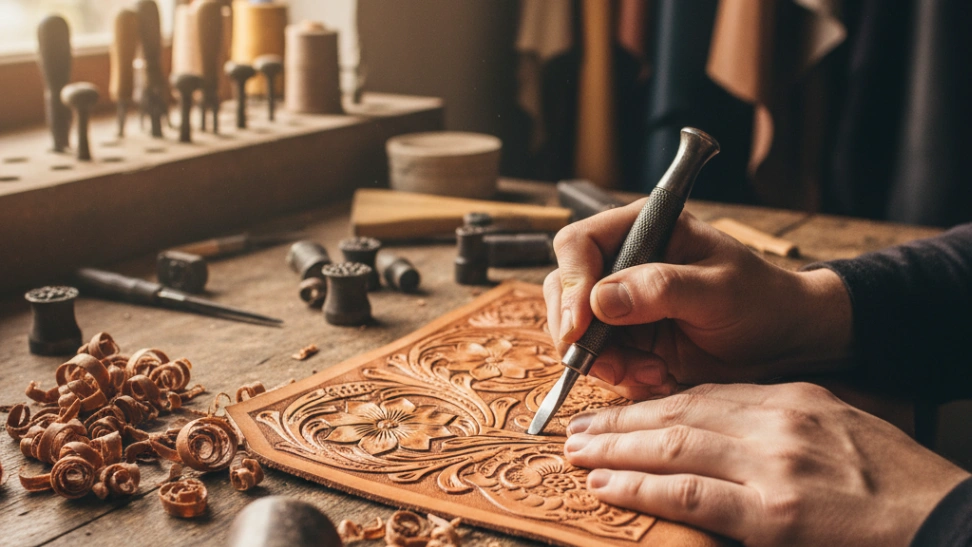The history of leatherworking stretches back tens of thousands of years, making it one of humanity's oldest crafts. Early humans quickly discovered that animal skins, a byproduct of hunting, could be transformed into essential items like clothing, shelters, and tools. Evidence of tanned hides and leather artifacts has been found dating back to the Stone Age, demonstrating its critical role in survival and development across diverse cultures. Ancient Egyptians utilized leather for sandals, garments, and even chariot components, while Romans were renowned for their sophisticated leather armor, shields, and tents. Indigenous peoples worldwide, from Native Americans crafting moccasins and pouches to various African tribes creating intricate masks and drums, developed unique and elaborate leatherworking traditions. The Middle Ages saw the rise of specialized guilds for shoemakers, saddlers, and tanners, elevating the craft to a respected profession. Over centuries, techniques evolved, incorporating new tools, dyes, and decorative methods, leading to the rich tapestry of leather artistry we see today. The introduction of industrial tanning processes in the 19th century revolutionized production, making leather more accessible, but the allure of handcrafted, artisanal leather items has never faded, ensuring the traditional craft's enduring legacy and continued appeal to hobbyists and professionals alike. The depth of its history is part of what makes leatherworking such a rich and meaningful pursuit, connecting modern makers to a lineage of craftsmanship that spans millennia.
At its core, leatherworking involves selecting the right type of leather for a project, whether it's vegetable-tanned for tooling and carving, chrome-tanned for softer garments, or exotics like alligator or stingray for luxury items. The process typically begins with pattern design and cutting the leather pieces precisely. Edges are often beveled and burnished to create a smooth, finished look. Stitching is a fundamental skill, usually performed by hand using a saddler's stitch for maximum durability, though machine stitching is also common in production settings. Beyond the basics, the hobby delves into various decorative techniques such as carving, stamping, dyeing, antiquing, and painting, allowing for immense artistic expression. Understanding the properties of different leathers—their thickness, temper (pliability), and grain—is crucial for successful project execution and achieving the desired aesthetic and functionality. Working with leather also requires an appreciation for its natural imperfections and characteristics, which can often be incorporated into the design to enhance its unique appeal.
The initial investment in tools can vary, but a basic kit often includes sharp knives or rotary cutters, mallets, awls, stitching chisels, needles, thread, and various edge-finishing compounds. As one progresses, specialized tools for carving, stamping, and complex hardware attachment become desirable. Developing fine motor skills, patience, and an eye for detail are paramount. Learning to execute precise cuts, consistent stitches, and effective tooling techniques takes practice and dedication. Problem-solving is frequently required when adapting patterns, correcting mistakes, or innovating new designs. The satisfaction derived from transforming a raw hide into a meticulously crafted object, imbued with the maker's time and effort, is a significant draw. It's a journey of continuous learning, where each project builds upon previous skills and introduces new challenges and creative possibilities, fostering both technical mastery and artistic growth.
Despite its ancient roots, leatherworking remains a vibrant and evolving craft in the modern era. A strong global community of artisans, hobbyists, and enthusiasts shares knowledge, techniques, and inspiration through online forums, social media, workshops, and local guilds. Many contemporary leatherworkers blend traditional methods with modern design aesthetics, creating pieces that range from classic heritage goods to minimalist accessories and avant-garde art. The demand for handcrafted, durable, and ethically sourced leather products has also seen a resurgence, appealing to consumers who value quality, craftsmanship, and sustainability over mass-produced items. This renewed appreciation not only provides opportunities for professional artisans but also fuels the passion of hobbyists who find immense joy in creating tangible, beautiful, and lasting items that often become cherished heirlooms. The tactile nature of the material, combined with the satisfaction of creating something functional and beautiful by hand, ensures leatherworking's continued relevance and appeal.



